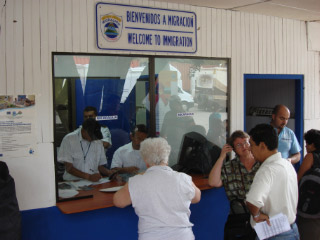
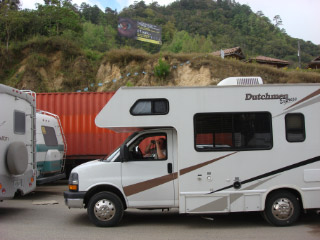
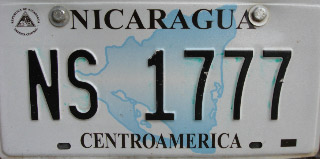
Chapter 6. Nicaragua



(Shari) Today is another border crossing. I have read that it is the worst
and most tedious border that we will cross and we are to have patience. As it
turns out, it is our easiest to date. Our guide meets us promptly and has
started the paperwork from the information Bert sent him in December. Within 15
min. we and our cars are checked out of Honduras. We move a few feet forward and
check into Nicaragua. This country requires liability insurance and although the
paperwork has been started, it has not been completed. We have driven in rig
order, but the man checking VIN numbers does not start at the beginning and
searches through his papers to find one of the rigs he stands in front of. It
happens he is at the end of the line and the last 4 papers are not finished yet.
As I help him find rigs from the names I read on the papers, I desperately want
to take the papers from him and just go down the line, 1,2,3,4 … But, alas,
those papers are his job and he is not about to hand them over to me. So he
laboriously looks at the license plate number trying to find the paper that
matches it. Craning my neck to look over his shoulder, I see the name on the
paper and do get him to follow me up and down the line to the correct vehicle.
Meanwhile, some of the local people milling around the border are becoming pesky
and ask for tips, food, pencils and whatever. Unfortunately some in our group,
even when we advised not
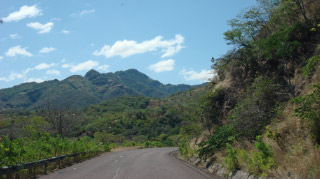 to do it, hand things out. That only causes more empty
hands begging for stuff. I am glad that our total elapsed time from start to
finish is only 2 hr. Unbelievable! Is it because we are such terrific leaders?
In fact, that may be part of it since we hired the right guides and the guides
had started the paperwork ahead of our arrival. I think we could have shaved 30
min. off of that time, had Mark and Joanie not changed their license plate and
the office did not tell us of the change. That meant the paperwork had to be
redone. Also, the insurance company missed logging Nelda and Gilford’s rig and
our insurance had been made out for 34 days and not 30. The worry wart that I
am, I caught all three mistakes which caused us to loose time now, but possibly
thwarted some fines later on. The road to and from the border runs through
unpopulated mountains. The scenery alone could be anyplace in the United States
that has long-needled pines in the mountains. Little traffic slows us and what
does, Bert passes quickly radioing to others when they too can pass on the
excellently-paved smooth surface. Our campsite tonight is quite a step up from
our gas station last night. We are on the spacious lawn of a private club that
has a huge clean swimming pool, showers and a restaurant for our use, plus a
dump and water. Bert and I eat lunch at the restaurant and head to the pool. The
water is too cold for me and I decide to take a shower back in the rig, but Bert
swims laps in the pool. After Bert’s bird talk and my travel meeting, we
socialize over margaritas and snacks.
to do it, hand things out. That only causes more empty
hands begging for stuff. I am glad that our total elapsed time from start to
finish is only 2 hr. Unbelievable! Is it because we are such terrific leaders?
In fact, that may be part of it since we hired the right guides and the guides
had started the paperwork ahead of our arrival. I think we could have shaved 30
min. off of that time, had Mark and Joanie not changed their license plate and
the office did not tell us of the change. That meant the paperwork had to be
redone. Also, the insurance company missed logging Nelda and Gilford’s rig and
our insurance had been made out for 34 days and not 30. The worry wart that I
am, I caught all three mistakes which caused us to loose time now, but possibly
thwarted some fines later on. The road to and from the border runs through
unpopulated mountains. The scenery alone could be anyplace in the United States
that has long-needled pines in the mountains. Little traffic slows us and what
does, Bert passes quickly radioing to others when they too can pass on the
excellently-paved smooth surface. Our campsite tonight is quite a step up from
our gas station last night. We are on the spacious lawn of a private club that
has a huge clean swimming pool, showers and a restaurant for our use, plus a
dump and water. Bert and I eat lunch at the restaurant and head to the pool. The
water is too cold for me and I decide to take a shower back in the rig, but Bert
swims laps in the pool. After Bert’s bird talk and my travel meeting, we
socialize over margaritas and snacks.
(Bert) Lee asks me what we will do this afternoon. I tell him we have no planned activities until 5 PM because we did not expect to get here at Estelí until late in the day, much less by lunchtime. He asks how we got through the border so quickly – it was only two hours to cross between Honduras and Nicaragua – and I say it is because this group is so smart and it has such good leaders. Lee always has a comeback, but this time I only see the mind-wheels spinning and he finally has to accept my statement.
At our 5 PM meeting I hand out a comparison chart on woodcreepers and another on ant-tanagers and we discuss the ways these species can be differentiated. Then I show a tentative list of the species I’ve recorded for the group and we make some additions and corrections. Our trip list is now just over 400 species, the exact number to be determined after I make the changes in my computer database.
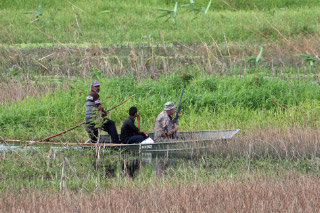 (Bert) Nicaraguan scenery today reminds me of dry Southern California
valleys, often flat and edged in foothills. We are on the Pacific slope now and
are seeing different birds, such as the Orange-chinned Parakeets at Estelí this
morning while we were filling our water tanks before departure. We pass
alongside rice fields, vibrantly green in contrast to the brown grasses
elsewhere. Hundreds of Black-necked Stilts feed in the swallow water. We stop at
a pullout next to a marsh with a few open water pools where coots and ducks
gather. A large flock of Fulvous Whistling-Ducks circles constantly above the
marsh, this species unexpected in Nicaragua according to Howell. The source of
agitation is three men in a boat. The one sitting in the bow looks like an
American chomping on an oversized cigar and holding a rifle, the second is a
young boy and the third stands at the stern and uses a long pole to push the
boat through the marsh. The big man sights a bird, aims his gun and shoots. He
kills a coot, a bird he could not legally shoot in the U.S. [After I posted this
journal on Yahoo-Groups, my friend and retired game warden wrote me to say in
Nevada you can shoot coots if you have a license to do so]. The dead bird
is ignored, for it appears his game is sport, not food. A few ducks still gather
farther ahead of his reach and in them I see an alternately plumaged Ruddy Duck,
another species not regularly expected in Nicaragua.
(Bert) Nicaraguan scenery today reminds me of dry Southern California
valleys, often flat and edged in foothills. We are on the Pacific slope now and
are seeing different birds, such as the Orange-chinned Parakeets at Estelí this
morning while we were filling our water tanks before departure. We pass
alongside rice fields, vibrantly green in contrast to the brown grasses
elsewhere. Hundreds of Black-necked Stilts feed in the swallow water. We stop at
a pullout next to a marsh with a few open water pools where coots and ducks
gather. A large flock of Fulvous Whistling-Ducks circles constantly above the
marsh, this species unexpected in Nicaragua according to Howell. The source of
agitation is three men in a boat. The one sitting in the bow looks like an
American chomping on an oversized cigar and holding a rifle, the second is a
young boy and the third stands at the stern and uses a long pole to push the
boat through the marsh. The big man sights a bird, aims his gun and shoots. He
kills a coot, a bird he could not legally shoot in the U.S. [After I posted this
journal on Yahoo-Groups, my friend and retired game warden wrote me to say in
Nevada you can shoot coots if you have a license to do so]. The dead bird
is ignored, for it appears his game is sport, not food. A few ducks still gather
farther ahead of his reach and in them I see an alternately plumaged Ruddy Duck,
another species not regularly expected in Nicaragua.
Today is Sunday and it seems the whole population is bicycling or walking along the roadsides. The highway is very good again and RV traveling speeds vary from 55 mph in the country to 30 mph when passing through the many small villages. Disturbingly, the roadsides near villages are littered with millions of pieces of household garbage, a feature we did not notice in Guatemala and barely saw in Honduras. Not far to Grenada, we soon reach our camping place in the parking lot of a marina on Lake Nicaragua, the largest lake in Central America. While I am helping others back into parking spots I notice hundreds of boisterous parakeets in nervous flocks circling the tops of the tall trees. After tending to chores and making arrangements for tomorrow’s boat trip, I join Joanie and then others birding along the entrance road. I see flocks of Scissor-tailed Flycatchers, find a dark phase Short-tailed Hawk, photograph a few Orange-chinned Parakeets and Joyce finds her lifer White-necked Puffbird for us, the first one for the trip.
(Shari) My brain hurts. Bert never understands a statement like that, but haven’t you studied something so hard that you get something like a headache? Well, my brain hurts from attempting to communicate with the people at the marina. Seems the owner has only told his administrator who has not told his employees of our arrival. How many more vehicles do we have coming I am asked after our first group of four arrive. Bert had worked out a plan for tomorrow about a boat trip, entrance to a private hacienda and lunch but no one at the marina knows about it and now I have to work out the details with them. “How many people for lunch?” “What time do we want the boat to arrive?” “Where are we going?” “How many boats?” “What do we want to eat?” Etc., etc. No one knows even ONE word of English to help me out. I know the cost of the total package but it seems they want me to separate the boat price from the meal price. How should I know? I have to talk to the restaurant manager (no English), who also knows nothing of our arrival. It is hot and I am sweating and I am tired. I ask if we could please just call the owner. The cell phone doesn’t work and after a few failed attempts, Bert finally gets to talk with him. You’d think now it is solved since I have been at this for at least 90 min. so far. The owner talks to his administrator, who talks to his assistant, who talks to the restaurant manager. I am told to get menu choices – beef, fish or chicken - from my people. I go to each rig with my clipboard to take orders, only to be bombarded with more questions: “How is the fish cooked?” “What kind of fish?” “How is the chicken prepared?” “Is there a sauce on the beef?” “I don’t care what I pick – no, I do not eat beef.” “I don’t know, maybe fish, no I think chicken.” “What kind of topping is on the chicken?”
My brain hurts more. I am hotter. Finally I get all the orders, take them to the restaurant and make lunch at 1:45. It is so hot that I am literally dripping with perspiration. I take my plate outside to sit in the breeze and no sooner sit down when the guide for the Panama group arrives. Between bites of sandwich I tell him we are birders and do not need to book his other tours. He tells me that he told me he was going to come and he always keeps his promises. He will return tomorrow to discuss helping us to cross into Costa Rica and make arrangements for our laundry. Then the owner of the marina shows up with three friends from New York. We chat for awhile and they seem nice and I get the impression that he does not come around often, but just wanted to see what we were all about. Because of the fiasco with the payment of the boat driver instead of the boat owner at Lago de Yojoa, I ask who I should pay for our trip tomorrow. I am told to pay Angel, the assistant to the administrator for all the monies. Darkness and mosquitoes descend forcing Bert and me inside to eat buffalo burgers from Wisconsin, a green salad and broccoli. Tonight I need the extra coolness of the O2 Cool devise before I finally fall asleep.
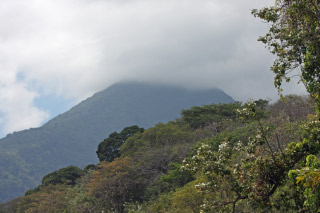 Day 30 – February 11 – La Calera Reserve
Day 30 – February 11 – La Calera Reserve (Bert) Usually from a boat all eyes are on the water and the shore. This morning we focus on the sky and the dozens of raptors soaring high in the thermal uplift where mountain slopes meet the lake. Amongst the many vultures we see a Short-tailed Hawk, perhaps the same one we saw yesterday, a handful of Ospreys and a very small bird that gets us excited. White and black below, kite-shaped and the size of a kestrel, looking tiny compared to the vultures, it is a Pearl Kite, a life bird for me and most in the group.
The two boats carry us to La Calera Reserve, a private hacienda on the slopes
of Volcán Mombacho. We split into two groups, following our guides Alex and
Alfredo and several other men who work here on the farm. The path leads through
primary forest along the marsh and hotsprings. One of the first birds we dismiss
quickly as a Golden-fronted Woodpecker, thinking it odd that it has a yellowish
belly instead of the usual pinkish. A perched hummingbird gets our attention,
all green with an orange bill and forked tail, a Salvin’s Emerald, a race of
Canivet’s Emerald. We puzzle over a bird call until Chris suspects
Turquoise-browed Motmot and I dial the call on my iPod. It matches and within
minutes Kay finds the bird. Alfredo tells us the motmot is the national bird of
Nicaragua. After hiking the lowlands we climb uphill and enter a banana
plantation and again see the woodpeckers, but their call is not the familiar
Golden-fronted call. Now we recognize we misidentified the first ones too and
these are Hoffman’s Woodpeckers, whose range we just entered. Alfredo sees a
bird run into the tangled forest undergrowth. He knows all of the birds by the
Latin genus and species names, but we do not. So he thumbs through Van Perlo’s
book and points to Lesser Ground-Cuckoo. I play its call and within seconds we
get an enthusiastic response of the same varied set of calls. The bird does not
come into the open though. We rendezvous at the boat dock and by noon we are
heading back to the marina through choppy waves.
After lunch and a short break we drive to El Guayabo in search of Nicaraguan
Grackle. The location is beside a dusty road, stirred up by the perpetual winds
of Lake Nicaragua. Great-tailed Grackles are numerous and Alex tells us the
Nicaraguan Grackles prefer the wetlands. We search for an hour, seeing few birds
as the winds keep them down in the vegetation or speed them in flight. Each
grackle seems to be Great-tailed until Joanie and I and a few others see a small
flock of at least one Great-tailed and two to three shorter tailed Nicaraguan
Grackles. They land in a tree with branches so dense we can only see a head poke
up once and a while in the wind tossed leaves. Eventually we get many looks at
shorter tailed birds and convince ourselves we are seeing both species. I
cannot seem to get a good photo of the grackles, but I do photograph a
Spot-breasted Oriole.
(Shari) In hindsight, today is a funny story, but it sure was not earlier. How hard can it be to spend $1200, made up in two invoices, agreed upon months ago via e-mail? We have had our boat trip (nice), hiked the private reserve (hot, not so nice) and ate our lunch (nice). Now I am to pay the bill. Taking my directions from the Bert’s e-mails, the boat and restaurant is to be paid with cash and the camping with a credit card. Not hard, right? In spite of our long conversation yesterday, Angel still seems to think the restaurant and the boat are separate but I do not know how much either is, since that is their internal affair. She gets Alex, our birding guide, to translate. He tells her what I tell him but he does not tell me what she says. She does not seem to understand that the bill is to be paid in U.S. dollars, one in cash and one with a credit card. She has the e-mails in front of her and Alex reads them to her. She asks Alex and me to walk to her office. Here she talks with her administrator. She then talks to Alex. Alex talks to me. We repeat the whole thing again. She still wants me to pay the restaurant separately. Finally I ask how much the restaurant bill is. I subtract the amount from the total and figure that should be the amount of the boat. I then ask how much the boat is. Whalla! The two figures add up to the total. So I tell Alex who tells her who talks to Alex who tells me that I have to pay for the drinks. I tell Alex that the restaurant manager said that drinks were included. Alex tells Angel. Angel calls the restaurant manager. The restaurant manager agrees with me. Now I am told that some of the people had water and that is extra. I ask how much is the water? How much is the coke? The water is $1 and the coke is $1.20. I say, that the restaurant makes out better if some had water. Then I am told that some people had two drinks. I ask how many had two drinks. I am told 7. By now my brain really really hurts. I give up and agree to pay the extra $7.
Okay, seems the bill for camping is now $240 more than anticipated because some of the rigs plugged into the one 15-amp electrical socket even though the agreed upon price was for the use of the marina. I say that I did not know this beforehand. Alex talks to Angel. Angel talks to the administrator. The administrator calls the owner on the cell phone that does not work very well. The administrator comes back and talks to Angel. Angel talks to Alex. Alex tells me the cost is now $8 per night per rig. I tell them all that I need to go ask my husband. Bert gets upset and talks to those plugged into the outlet. They decide not to use the electricity and remove the daisy-chain of extension cords all linked to the single 15-amp outlet. I tell Alex to tell Angel that. I pay the bill. Now I ask for receipts. Alex talks to Angel … Needless to say you get the picture.
My day is not done yet. The guide from yesterday who told me he always does what he says he is going to do, has not shown up to deal with the laundry. I have EVERYONE’S dirty clothes in R-Pup-Tent. I have to move three big bags to open the bathroom door. To go outside, I have to move bags. To open the frig I have to move more bags. Twelve bags of dirty laundry take up a lot of room. I see the administrator and ask him about a lavanderia por ropas sucias for pick up today and return tomorrow. I think he understands since I hear the work preguntar (ask) when he answers me. I think he said that he will ask and get back to me in an hour. Two hours later he has not returned. I guess people will just have to pick up their bags of dirty clothes so that I can go to bed. As Bert is explaining tomorrow’s schedule to the group, Angel comes to me with a piece of paper written in English announcing a laundry service. I get Chris to help with translation and within a half hour someone is knocking on our door for laundry pickup. As I wave goodbye to my dirty clothes, I am thankful that not all days are like this one. After a cold bowl of soup and cold shower, I collapse into bed.
(Shari) “Oh, shut up! Shut up! Shut up!” I shout at my alarm at 5 AM. Turning over in bed, I debate if this trip to the volcano is worth getting up so early. Nonetheless, from past experience I know I will be awake as soon as Bert moves about in preparation for his departure. Grumbling, I get myself up and dressed. I am pleasantly surprised to see the bus when I alight from R-Pup-Tent. I am never sure if our plans will materialize. Our short drive to Mombacho Volcano in the bus is pleasant since I do not have to navigate and just look out the window as our driver weaves around potholes, bicyclists, pedestrians, buses, other cars and trucks and kids in school uniforms. Alex meets us on the road and upon getting out of the bus I am peppered with questions. I know no more than what I was told last night and just shrug my shoulders. “What time?” “How long?” “Where is lunch?” “Can I leave stuff on the bus?” “How difficult is the path?” “Where is the bathroom?” “When should I be back?” Etc., etc., etc., etc., etc.
Alex tells us a bit about the dormant volcano, the paths, and the private coffee plantation. Splitting into two groups, I join the smaller with Alfredo as our guide. We don’t walk 100 yards before the group stops to decipher the sound of a bird. Alfredo knows the bird in Latin but not English so they pore over the books to find its picture. I walk on without them but soon come to a fork in the path and do not know which way to go. I return, frustrated and walk back to the picnic tables in the shade to write journals. Writing about the experience of yesterday and the day before is therapeutic and now funny in the retelling. A ranger comes up and asks me in Spanish how many people I have and when they will be going up to the volcano. I tell him in Spanish. I understand him and he understands me on the first try so I am not a complete idiot. I feel good again.
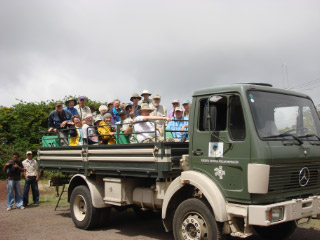 At 8:30 we pile into a 4-wheel-drive open-air truck that will take us up the
3000 ft. to the rim of the crater. We climb and climb and climb some more. I
look around and everyone has a smile on their face. We are enjoying this. The
scenery is fantastic, we see a motmot and the weather is perfect. Finally we hit
the clouds and the wind picks up. By the time we reach the top it is downright
cold and blustery, reminding many of us of a ski lodge at the top of the slopes.
Inside we gather around and are peppered with more questions. We learn that we
should pay our entrance fee before we start to walk. We should order our lunch
first so it is ready when we return. Alex shows us the paths and off we go. Pat
and I walk to the rim lookout but see nothing through the clouds. We return to
the shelter, joining Ralph, Dorothy, Carol and later Bob and Arleen. Bob comes
back to tell us that the clouds have parted and we dash out to see the view. My
goodness it is beautiful, the whole city stretches out far below us. We can make
out the cathedral, the cemetery and the marina on the shore of the lake. The
group returns telling us of few birds but many exhilarating views.
At 8:30 we pile into a 4-wheel-drive open-air truck that will take us up the
3000 ft. to the rim of the crater. We climb and climb and climb some more. I
look around and everyone has a smile on their face. We are enjoying this. The
scenery is fantastic, we see a motmot and the weather is perfect. Finally we hit
the clouds and the wind picks up. By the time we reach the top it is downright
cold and blustery, reminding many of us of a ski lodge at the top of the slopes.
Inside we gather around and are peppered with more questions. We learn that we
should pay our entrance fee before we start to walk. We should order our lunch
first so it is ready when we return. Alex shows us the paths and off we go. Pat
and I walk to the rim lookout but see nothing through the clouds. We return to
the shelter, joining Ralph, Dorothy, Carol and later Bob and Arleen. Bob comes
back to tell us that the clouds have parted and we dash out to see the view. My
goodness it is beautiful, the whole city stretches out far below us. We can make
out the cathedral, the cemetery and the marina on the shore of the lake. The
group returns telling us of few birds but many exhilarating views.
Going downhill, the way back on the truck is harder since we have to brace ourselves from tipping forward. The bus driver takes us to the bank to get money at the ATM and then a somewhat large grocery store. We are allotted 30 min. and I rush out and whiz around the cramped aisles picking up bread, milk, fruit, veggies, cheese, etc. Others are doing the same. Finishing in about 20 min., I see others are already back on the bus. We start to take bets on who will be last and Charlu and Tom are the favorites, hands down. Boy are we surprised when they come back before two other couples. We tell Charlu how surprised we are and she sings “nah.. nen nah.. nen.. nah nah.” Mike and Kay win the prize for last place. Clay says he has bad news. He saw someone in the store wearing a shirt just like the one he sent out to the laundry. We wonder where he comes up with all his quips. He must stay up at night, just thinking of them.
Returning to the marina parking lot, we put away our groceries, the guide from the Panama group arrives and arranges for our border crossing in two days and Bert has a bird count and delightedly the lady with our wash arrives. The breeze is strong, keeping the mosquitoes at bay and we sit outside until almost 7 PM discussing with Bob and Arlene how to handle all the group questions. This group is one of our best but also one with the most questions: some valid, but some from not listening at group meetings and others from being unaware of the surroundings or unmindful of answers given to someone else. I still love this group since it gets along so well with no complainers. The people are very flexible and can handle changes in the plan with ease and leave their attitudes in their rigs. But the questions are hindering us from doing our job. We can only handle one thing at a time and cannot be interrupted when paying a bill, or talking with the bus driver about plans or with the guide about details just to answer someone about the location of the bathroom. I suppose it is not that they don’t want to wait their turn, but are anxious to get birding. I am sure we will solve this issue and if that is all I have to complain about, I guess I should not complain.
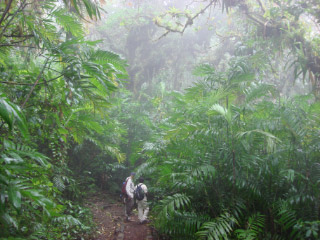
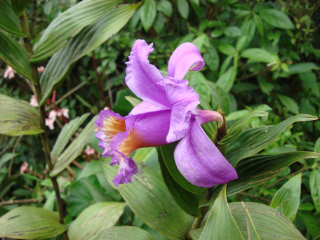
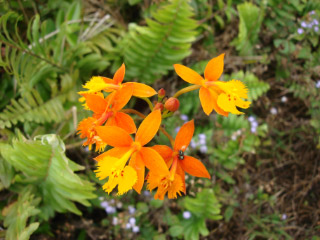
(Bert) The bed of the huge truck supports all of us on bench seats in the open air. Railings give us support from the jostle of what often feels like a 45º vertical climb as the engine labors in first gear. A Turquoise-browned Motmot and then a Squirrel Cuckoo swoop across the road in front of us, alighting in the dense canopy that surrounds the sides of the narrow brick road. Nearing the top of the volcano, 5.5 km from the parking lot where we left our bus, the winds blow and the temperature drops. I left my rain jacket in the bus, so Shari lends me hers since she brought an extra shirt also.
The volcano last erupted in 1586. Now as we look down from the rim into the 600-ft. deep crater we see a lush tropical forest bathed in a cloud laden with mist. Moisture adheres to the leaves we recognize as house plants. Pink orchids, including some that bloom for only one day, grow from tree branches. Every tree fork and branch is densely covered with bromeliads. At first it seems surprising that we hear almost no birds and see only one or two. Although the cloud forest seems tremendously supportive of birds, we suspect that the isolated volcano peak is like an island remote from similar habitat. Mark and Joanie report they saw a Mountain Elaenia while the rest of us were paying entrance fees. Together as a group hiking the crater edge we find a Purple-throated Mountain-Gem at one of the lookouts. The hummingbird is fast and it rests for mere seconds under that dark canopy. At the mountainside overlooking Lake Nicaragua we hear a Plain Wren that refuses to come into the open. When we arrived at the visitor’s center and restaurant at the top of the volcano, my GPS measured an elevation of 3815 ft. Our viewpoint gives us a grand view of flatlands surrounding the city of Grenada (about 200,000 pop.), the shoreline of vast Lake Nicaragua (elevation 150 ft.), the islands which are artifacts of a past volcano, and the farmlands, hotsprings and primary forest of La Calera Reserve where we were yesterday. On the way down the mountain we stop at the coffee plantation where beans dry on broad concrete slaps, occasionally turned by workers using long rakes. Surrounding the house, where some sip the plantation grown coffee, blooming flowers attract nectar seekers and we add Steely-vented Hummingbird to the list. In the city we stop at a grocery store, more amply supplied than the street side vendors we’ve seen before, and everyone gets a half-hour to do some quick shopping to replenish supplies.
(Bert) An hour’s bus ride takes us to the entrance road for El Chocoyero,
then the bus takes the narrow 1-lane, highly banked, dusty road through
countryside and uphill for another half-hour, ending in an inviting high-canopy
forest. We are about to split into two groups when an Orange-billed
Nightingale-Thrush appears near the headquarters buildings. I snap a quick
photo, but get an even better one of another bird later in the morning. A couple
of Yellow-billed Caciques are the first of the trip although not everyone gets a
good look at these birds that keep to dark undergrowth with only a straw-colored
bill to give away their hiding place. Alfredo catches a small snake locally
called a rat snake, but looks more like what we call ribbon snakes due to its
size. Juan, a local guide and birder, takes the lead of our group and has sharp
eyes and good ears for the birds. Maybe he knew its roost, for it seems
impossible that he finds an owl perched only a dozen feet from us at eyelevel,
yet is so well hidden we have to kneel to see it through the brush. We see the X
across its forehead and at such close range some think we have a rare owl. It
looks like a Mottled Owl to me and after a quick examination of the books we all
agree. Nonetheless, this is the closest I’ve gotten to one and the photos show
the owl full frame, although crisscrossed with branches.
Clearly the best bird of the day for me is the Long-tailed Manakins. In spite of them being quite common here, as evidenced by the many times we hear the calls along the trail, we have a hard time actually seeing them. In dense dark woods where everything looks black with spots of intruding sunlight, the manakins are a startling sight with red crowns, blue bodies and long tails. Juan tries valiantly to find perched birds for me to photograph, but by the time I can see to where he is pointing and focusing on the spot – often manually because autofocus works poorly through the interleaving branches – the bird has moved to another perch.
Unlike the brief look yesterday at a Blue-throated Goldentail, today we see
several males and females that perch for long periods, giving us time to study
its field marks and for me time to photograph.
And I finally get photographs of Plain Wren
,
a bird that usually hides so well I can barely see it.
We again find a troop of Mantled Howlers, the third day in a row. The monkeys
we see most often throughout Mexico, Belize and Guatemala are Yucatan Black
Howlers. The Mantleds are smaller and have reddish backs. They also seem to be
less given to the boisterous outbreaks of roaring calls.
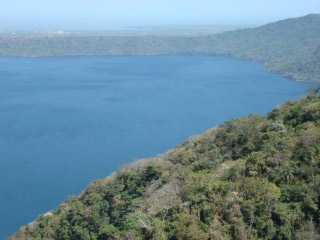
The trail ends at a high thin waterfall that pours over a vertical rock wall. Juan tells us that at 5 PM five hundred Pacific Parakeets arrive and squabble over roosting holes in the rock wall. We wish we could stay so late to see the event.
Birds are everywhere along the trail and our day’s list grows to 71 species, very good for a dark forest. We finish at noon and drive to Catarina, a village atop a mountain overlooking Laguna de Apoyo, a deep blue lagoon very much resembling Crater Lake in northwest U.S. The deep hole is the inverse of the high volcano nearby and filled with salty water a remnant from the sea when volcanoes formed the connection between North and South America. Five restaurants offer cliff-side tables overlooking the blue lake and we spread out among them, enjoying tasty midday meals.
(Shari) I guess I made the wrong choice today. The group comes back with tales of a lagoon like Crater Lake, cool temperatures, fantastic scenery, great lunches and even artisan shopping. Darn! I did get to sleep in late. I stayed back at the marina catching up and recharging my batteries. I did enjoy a nice lunch with Ralph and Dorothy made even better when Ralph picked up the tab. And I did make chicken and rice salad. Win some, lose some!